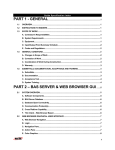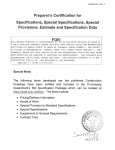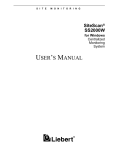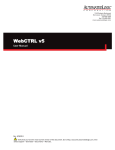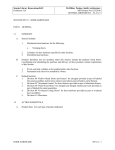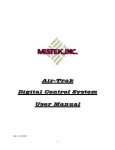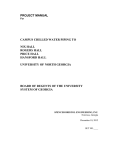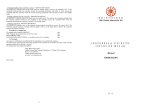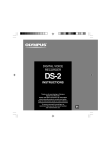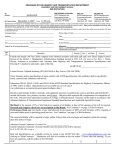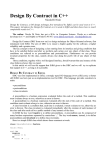Download MASTER SPECIFICATION
Transcript
DRAFT SECTION 15950 BUILDING AUTOMATION SYSTEM PART 1 - GENERAL 1.1 RELATED DOCUMENTS A. 1.2 1.3 OVERVIEW A. This document contains the specification, input/output summaries for a Direct Digital Control (DDC) Building Automation System (BAS). B. The system architecture shall utilize intelligent distributed control modules, which communicate either over telephone lines using dial-up modems to a Central Site. The Central Site shall be an Intel Pentium processor based computer, with color graphics and associated printers. C. The system shall provide the Direct Digital Control, Energy Management and Building Automation for the air conditioning, heating and ventilating systems as shown on the drawings and as specified. QUALITY ASSURANCE A. 1.4 The requirements of the General Conditions, Special Conditions and Section 15010, Mechanical General, apply to all work specified in this section. The BAS shall be the Automated Logic System 20/20, manufactured and installed by ALC Controls, Inc or approved equal by Siemens or Honeywell. SCOPE OF WORK A. Furnish and install all necessary hardware, wiring, computing equipment and software as defined in this specification. B. System requirements: 1. 2. 3. C. All material and equipment used shall be standard components, regularly manufactured and available and not custom designed especially for this project. All systems and components, except site specific software, shall have previously been thoroughly tested and proven in actual use prior to installation on this project. The system architecture shall be fully modular permitting expansion of application software, system peripherals, and field hardware. The system, upon completion of the installation and prior to acceptance of the project, shall perform all operating functions as detailed in this specification. Equipment: 1. Milton Court/Fire/Police A11-207/10-12 Provide the following system hardware: a. Central site stand-alone control modules and laptop. b. All sensing devices and necessary transducers to perform the functions. c. All relays, switches, indicating devices, and transducers required to perform the functions specified. BUILDING AUTOMATION SYSTEM 15950-1 DRAFT d. e. f. D. 1.5 Provide and install all system software identified in this Section. The database required for implementation of this specification shall be provided including point descriptor, alarm limits, calibration variables, graphics, reports and point summaries. COORDINATION AND WARRANTY A. Promptly correct all work found finds defective or failing to conform to the Contract Documents. Bear all cost of correcting such work. B. If, within the warranty period required by the Contract Documents, any of the work is found to be defective or not in accordance with the contract documents, correct it promptly after receipt of written notice to do so. Prompt notice shall be given after discovery of the condition. C. 1.6 All monitoring and control wiring. All modems and accessories. All damper actuators and controls shall be electronic. Warranty: Warrant that all systems, subsystems, component parts, and software are fully free from defective design, materials, and workmanship for a period of one year from the date of final acceptance. SUBMITTALS, DOCUMENTATION AND ACCEPTANCE A. Submittals: 1. 2. 3. 4. 5. Milton Court/Fire/Police A11-207/10-12 A minimum of 4 copies of shop drawings shall be submitted and shall consist of a complete list of equipment and materials, including manufacturer's descriptive and technical literature, catalog cuts, and installation instructions. Shop drawings shall also contain complete wiring, routing, schematic diagrams, tag number of devices, software descriptions, calculations, and any other details required to demonstrate that the system shall function properly. Drawings shall show proposed layout and installation of all equipment and the relationship to other parts of the work. Shop drawings shall be approved before any equipment is installed. Therefore, shop drawings shall be submitted in time for review so that all installations can be completed per the project's completion schedule. Ten working days shall be allowed for review of submittals. All drawings shall be reviewed after the final system checkout and updated or corrected to provide "as-built" drawings to show exact installation. All shop drawings shall be acknowledged in writing before installation is started and again after the final checkout of the system. The system shall not be considered complete until the "as-built" drawings have received their final approval. Deliver 4 sets of 'as-built' drawings. Before final configuration, provide Input/Output (I/O) summary forms that include: a. Description of all points. b. Listing of binary and analog hardware required to interface them to equipment for each function. c. Listing of all application programs associated with each piece of equipment. d. Failure modes for control functions to be performed in case of failure. Provide an accurate graphic flow diagram for each software program proposed to be used on the project as part of the submittal process. Revisions made as a result of the submittal process, during the installation, start-up or acceptance portion of the project, shall be accurately reflected in the "as-built" graphic software flow diagrams herein required by this specification. BUILDING AUTOMATION SYSTEM 15950-2 DRAFT 6. B. Operations and maintenance manuals for the system shall include a User’s manual, product information and graphic programming. Project specific manuals shall include detailed information describing the specific installation. 1. 2. 3. C. User’s manual shall contain as a minimum, an overview of the system, its organization, the concepts of networking and central site/field hardware relationships as well as the following: Product information shall include detailed information on hardware and design requirements for initial installations and/or additions to existing systems. Installation mounting and connection details for field hardware, accessories and central site equipment. Graphic programming shall contain as a minimum descriptions of the control software programs used in the system. A graphic flow diagram for each software application program provided as part of this project. Acceptance test and acceptance: 1. 2. D. Furnish and install software to simulate the operation of all software application programs to ensure they are free from design errors and that they accurately accomplish the application sequence of operations. The simulation shall show each output value and how it varies in relation to an artificial time clock. The time clock shall run at normal time increments, increased increments (fast motion) or decreased increments (slow motion). Upon completion of the installation, start up the system and perform all necessary calibration, testing, and debugging operations. An acceptance test shall be performed in the presence of the Owner's representative. When the system performance is deemed satisfactory, the system parts shall be accepted for beneficial use and placed under warranty. At this time, a "notice of completion" shall be issued and the warranty period shall start. Provide full instructions to designated personnel in the operation, maintenance, and programming of the system. The training shall be specifically oriented to the system and interfacing equipment installed. Four hours of training for the BAS shall be provided. PART 2 - PRODUCTS 2.1 OVERVIEW A. The entire system, when complete, shall have a central site. This central site shall be linked to one or more Local Area Networks via auto dial/auto answer modems and separate voice grade telephone lines or via hardwired RS-232 cable. To enhance reliability of the system, the central site system shall be used only as an interface to the LAN, not as an active control system. B. The site shall be equipped with a Gateway Communications Module and a number of control modules. This combination of Gateway and control modules make up the LAN for that site. C. The central site shall interrogate any module in addition to downloading program changes to individual modules. D. Each control module shall initiate all alarm reporting and selective data uploading to the central site. All Control modules shall communicate with each other. Milton Court/Fire/Police A11-207/10-12 BUILDING AUTOMATION SYSTEM 15950-3 DRAFT E. 2.2 Control modules shall be microprocessor based and operate in a stand-alone mode. All control modules shall contain all necessary software programs to provide DDC and energy management functions to the equipment being controlled. CENTRAL HARDWARE A. Provide a central site system configuration that includes, as a minimum, the following components. 1. 2. 3. 4. 5. 6. B. 2.3 Windows compatible Pentium CPU, 233 MHZ clock speed with a 1 gigabyte (GB) hard disk, 64 MB random access memory (RAM) and expandable to 256MB, two parallel and two asynchronous serial ports shall be provided for connection of peripherals, one 1.44M-3 1/2" floppy drive, one IOMEGA ZIP drive and one 6X CD ROM drive. Operating system for the computer operator workstation shall be Microsoft Windows 95/98 or Windows NT 4.0. Any software being provided for this system which is not a true 32-bit Windows 95/98 or Windows NT 4.0 or uses a modified Operating System (OS) will not be acceptable. The primary operator interface device shall consist of a 2-button mouse. An enhanced keyboard with 101-key layout and dedicated numeric keypad for rapid data entry shall be provided. Color graphics monitor and video controller shall provide a high resolution, color SVGA monitor to display real time dynamic graphic data, execute operator commands and report system activity. Graphics monitor shall be at least a 17" color display with a dark edged screen to reduce glare. Video resolution shall be minimum 1024 by 768 pixels 24 bit True Color. Provide an alarm and report printer as a part of each operator workstation. This printer shall be minimally capable of graphics and at least 132 characters per second for data print and able to provide near letter quality print. The BAS shall have modem compatibility with EIA-232C connection and automatic answer/originate capability for each Operator Workstation. Minimum speed shall be 28.8 Kbps. Furnish a portable computer for a site interface with the modules to allow repair and maintenance personnel to perform diagnostics, interrogate any point and reprogram in the field. All reprogramming shall be dependent upon a minimum of six levels of security accessing. The terminal shall have the following: Pentium or higher processor, 8 MB RAM, 1.44M floppy, VGA backlite LCD display, internal 9600 Baud or higher modem, 2 serial and 1 parallel ports and 850 MB hard disk or higher. FIELD HARDWARE A. Field hardware shall be of a modular design to ensure reliability and system performance. B. Local Area Network Gateway (LAN Gateway): 1. 2. Milton Court/Fire/Police A11-207/10-12 The LAN Gateway shall be a microprocessor based communications device which functions as a communications gateway between a controller network and a Local Area Network (LAN). It shall communicate with controllers utilizing ARCNET over EIA-485 network at 156 Kbps and shall be capable of acting as a bridge and router between designated BACnet data links and the ARCNET data link. It shall offer PTP to ARCNET and BACnet/IP to ARCNET routing capability. Controller networks that utilize proprietary protocols at the controller network level will not be acceptable. Each LAN Gateway shall support a controller network on which may reside up to 100 controllers. BUILDING AUTOMATION SYSTEM 15950-4 DRAFT 3. 4. 5. 6. 7. 8. 9. C. The controller network shall use BACnet as its native communication protocol. The communication between controllers shall be at least 156 Kbps using ARCNET implemented over EIA-485 using an unshielded twisted pair at the Data Link Layer. The LAN which interconnects LAN Gateways may be configured as EIA-485 (38.4 kbps), Ethernet (10 Mbps), Token Ring (16 Mbps), or FDDI (100Mbps), all of which may be implemented over fiber optic, twisted pair or coaxial cable. In the case of Ethernet connections, the LAN Gateway may be configured as Ethernet 10BaseT(10Mbps) which may be implemented over unshielded twisted pair. The LAN Gateway shall provide two EIA-232 ports which can be connected to Operator Workstations, portable computers or modems. LAN Gateway shall provide full arbitration between multiple users whether they are communicating through the same or different LAN Gateways. The LAN Gateway shall be responsible for routing global information from the various controller networks which may be installed throughout the building. A total of 255 LAN Gateways shall be supported on each LAN, each LAN Gateway supporting a minimum of 100 controllers. The LAN Gateway shall be capable of utilizing FLASH memory which allows firmware updates to be performed remotely. General Purpose/Multiple Application Controllers: 1. 2. 3. 4. 5. Milton Court/Fire/Police A11-207/10-12 Purpose/Multiple Application controllers shall use BACnet as the native communication protocol between controllers and shall, as a minimum, support the following Objects and Application Services (Conformance Class 3): Objects > Binary Input Services > Read property Binary Output Write property Binary Value I-Am Analog Input I-Have Analog Output Read Mutiple Property Analog General Value Write Multiple Property Calendar Who-Has Schedules Who-Is Each General Purpose/Multiple Application Controller shall be capable of standalone direct digital operation utilizing its own 32 bit processor, non-volatile flash memory, input/output, 12 bit A to D conversion, hardware clock/calendar and voltage transient and lightning protection devices. All non-volatile flash memory shall have a battery backup of at least five years. Firmware revisions to the module shall be able to be made from the local workstation, portable operator terminals or from remote locations over modems or LANs. The General Purpose/Multiple Application Controllers shall be expandable to the specified I/O point requirements. Each controller shall accommodate multiple I/O Expander Modules via a designated expansion I/O bus port. These expander modules shall expand the total point capacity of each controller up to 192 points where specified. The controller, in conjunction with the expansion modules, shall act as one standalone controller. All point data, algorithms and application software within a controller shall be custom programmable from the operator workstation. Each General Purpose/Multiple Application Controller shall execute application programs, calculations and commands via a 32 bit microcomputer resident in the controller. All operating parameters for application programs residing in each controller shall be stored in read/writable nonvolatile flash memory within the controller and will be able to upload/download to/from the operator workstation. BUILDING AUTOMATION SYSTEM 15950-5 DRAFT 6. 7. 8. 9. D. Each General Purpose/Multiple Application Controller shall reside on a BACnet communications bus and shall utilize native BACnet communications between all other controllers and devices on the network. Each controller shall include self-test diagnostics which allow the controller to automatically relay to the network controller any malfunctions or alarm conditions that exceed desired parameters as determined by programming input. Each General Purpose/Multiple Application Controller shall contain both software and firmware to perform full DDC PID control loops. Each General Purpose/Multiple Application Controller shall contain a serial port for the interface of maintenance personnel's portable computer. All network interrogation shall be possible through this port. Input-output processing: a. Digital outputs shall be relays, 24VAC or VDC maximum, 3 amp maximum current. Each configured as normally open or normally closed using jumpers and either dry contact or bussed. Triac outputs are unacceptable. Each output shall have a manual Hand-Off-Auto switch to allow for override and an LED to indicate the operating mode of the output. b. Universal inputs shall be Thermistor (BAPI Curve II) 10K Ohm at 77F (25C), 05VDC, 10K Ohm maximum source impedance, 0-20mA - 24 VDC loop power 250 Ohm input impedance, dry contact - 0.5mA maximum current. c. Analog output shall be electronic, voltage mode 0-10VDC or current mode 420mA. General Purpose/Single Application Controllers: 1. 2. 3. 4. Milton Court/Fire/Police A11-207/10-12 The General Purpose/Single Application Controllers shall use BACnet as the native communication protocol between controllers and shall, as a minimum, support the following Objects and Application Services (Conformance Class 3): Objects > Binary Input Services > Read property Binary Output Write property Binary Value I-Am Analog Input I-Have Analog Output Read Multiple Property Analog Value Write Multiple Property Calendar Who-Has Schedules Who-Is The General Purpose/Single Application controllers shall be capable of stand-alone DDC operation utilizing their own 32 bit processor, nonvolatile flash memory, input/output, 10 bit A to D conversion, hardware clock/calendar and voltage transient and lightning protection devices. All nonvolatile Flash memory shall have a battery backup of at least five years. Firmware revisions to the module should be able to be made from the local workstation, portable operator terminals or from remote locations over modems or LANs. All point data, algorithms and application software within the controllers shall be custom programmable from the Operator Workstation. Each General Purpose/Single Application Controller shall execute application programs, calculations and commands via a 32 bit microcomputer resident in the controller. All operating parameters for the application program residing in each controller shall be stored in read/writable nonvolatile flash memory within the controller and shall be able to upload/download to/from the Operator Workstation. BUILDING AUTOMATION SYSTEM 15950-6 DRAFT 5. 6. 7. 8. 9. 10. E. Each General Purpose/Single Application Controller shall reside on a BACnet communications bus and utilize native BACnet communications to/from other controllers and devices on the network. Each Controller shall include self-test diagnostics which allow the controller to automatically relay to the network controller any malfunctions or alarm conditions that exceed desired parameters as determined by programming input. Each General Purpose/Single Application Controller shall contain both software and firmware to perform full DDC PID control loops. A serial port shall be provided for the interface of maintenance personnel's portable computer. All network interrogation shall be possible through this port. The General Purpose/Single Application Controllers shall be capable of being mounted directly in or on rooftop equipment. The General Purpose/Single Application Controllers shall be capable of proper operation in an ambient temperature environment of -20F to +150F. Input-Output Processing: a. Digital outputs shall be relays, 24VAC or VDC maximum, 3 amp maximum current. Triac outputs will not be acceptable. Each output shall have a manual Hand-Off-Auto switch to allow for override and an LED to indicate the operating mode of the output. b. Universal inputs shall be Thermistor (BAPI Curve II) 10K Ohm at 77F (25C), 05VDC - 10K Ohm maximum source impedance, 0-20mA - 24 VDC loop power 250 Ohm input impedance, dry Contact, 0.5mA maximum current. c. Analog electronic outputs shall be voltage mode 0-10VDC or current mode 420mA. d. Enhanced Zone Sensor Input shall provide one thermistor input, one local setpoint adjustment, one timed local override switch and an occupancy LED indicator. Unitary controllers: 1. Milton Court/Fire/Police A11-207/10-12 Unitary controller interface: a. Each Unitary Controller shall communicate with the controller network through a Unitary Controller Interface (UCI). The UCI shall provide one EIA-485 port for a controller network connection and one EIA-485 port for the Unitary Controller connection. In addition a direct connect EIA-485 port shall also be provided for connection of a portable operators computer. b. The UCI shall use BACnet as the native communication protocol between controllers on the Controller Network and shall, as a minimum, support the following Objects and Application Services (Application Services are consistent with BACnet Conformance Class 3): Objects> Binary Input Services>Read property Binary Output Write property Binary Value I-Am Analog Input I-Have Analog Output Read Multiple Property Analog Value Write Multiple Property Calendar Who-Has Schedules Who-Is c. The UCI shall utilize the BACnet protocol for communication to the Unitary Controllers. The communication speed between Unitary Controllers shall be between 9600 baud to 38.4 kbps. d. A serial port shall be provided on the UCI for the interface of the operators portable computer. All network interrogation shall be possible through this port. BUILDING AUTOMATION SYSTEM 15950-7 DRAFT e. 2. Milton Court/Fire/Police A11-207/10-12 Each Unitary Controller Interface shall execute application programs, calculations and commands via a 32 bit microcomputer resident in the Unitary Controller Interface. All operating parameters for application programs residing in each Unitary Controller Interface shall be stored in read/writable nonvolatile flash memory within the controller and shall be transferred between Operator Workstation to the controller. All nonvolatile memory shall have a battery backup of at least five years. Firmware revisions to the controller should be able to be made from the local workstation, portable operator terminals or from remote locations over modems or LANs. f. The UCI shall contain both software and hardware to perform full DDC PID control loops. g. UCI circuits shall be optically isolated. Unitary controllers: a. The Unitary Controllers shall use BACnet as the native communications protocol between controllers on the unitary controller network and shall, as a minimum, support the following Objects and Application Services (Conformance Class 2): Objects > Binary Input Services > Read property Binary Output Write property Binary Value I-Am Analog Input I-Have Analog Output Read Multiple Property Analog Value Write Multiple Property Calendar Who-Has Schedules Who-Is b. Each Unitary Controller shall be able to support various type of zone temperature sensors such as temperature sensor only, temperature sensor with built-in local override switch or temperature sensor with setpoint adjustment switch. c. Each Unitary Controller for VAV application shall have a built-in air flow transducer for accurate air flow measurement in order to provide the Pressure Independent VAV operation. d. Each Unitary Controller for VAV applications shall have an integral direct coupled electronic actuator. The actuator shall provide on-off/floating point control with a minimum of 35 in-lb of torque. The assembly shall mount directly to the damper operating shaft with a universal V-Bolt clamp assembly. The actuator shall not require any limit switches, and shall be electronically protected against overload. When reaching the damper or actuator end position the actuator shall automatically stop. The gears shall be manually disengaged with a button on the assembly cover. The position of the actuator shall be indicated by a visual pointer. The assembly shall have an anti-rotational strap supplied with the assembly that will prevent lateral movement. e. Each Unitary Controller and Unitary Controller Interface shall have LED indication for visual status of communication, power and all outputs. f. In the event of a loss of communication with the Unitary Controller Interface each Unitary Controller shall control from a standalone algorithm which maintains the assigned space temperature until communication with the Unitary Control Module Interface is restored. g. Input/Output Processing: (1) Digital outputs shall be relays, 24VAC or VDC maximum, having a 3 Amp maximum current. Each relay shall be configured as normally open or normally closed, and either dry contact or bussed. Triac outputs will not be acceptable. BUILDING AUTOMATION SYSTEM 15950-8 DRAFT (2) (3) (4) F. Universal inputs shall be Thermistor Precon Type II, dry contacts or 05VDC with 0-10K Ohm input impedance. Enhanced Zone Sensor Input. The input shall provide one thermistor input, one local setpoint adjustment, one timed local override switch and an occupancy LED indicator. Analog output electronic, voltage mode 0-10VDC or current mode 420mA. Instrumentation and control: 1. 2. 3. Milton Court/Fire/Police A11-207/10-12 Input devices: a. Temperature sensors shall be of the type and have accuracy ratings as indicated and/or required for the application and shall permit accuracy rating of within 1% of the temperature range of their intended use. (1) Sensors used for mixed air application shall be the averaging type and have an accuracy of +1°F. (2) OA temperature sensors shall have a minimum range of –52°F to 152°F and an accuracy of within +1°F in this temperature range. (3) Room temperature sensors shall have an accuracy, of +0.36°F in the range of 45°F to 96°F. Pressure instruments: a. Differential pressure and pressure sensors shall have a 4-20 MA output proportional signal with provisions for field checking. Sensors shall withstand up to 150% of rated pressure without damaging the device. Accuracy shall be within +2% of full scale. Sensors shall be manufactured by Leeds & Northrup, Setra, Robertshaw, Dwyer Instruments, Rosemont, or be approved equal. b. Pressure switches shall have a repetitive accuracy of +2% of range and withstand up to 150% of rated pressure. Sensors shall be diaphragm or bourdon tube design. Switch operation shall be adjustable over the operating pressure range. The switch shall have an application rated Form C, snap-acting, selfwiping contact of platinum alloy, silver alloy or gold plating. c. Flow switches shall have a repetitive accuracy of +1% of their operating range. Switch actuation shall be adjustable over the operating flow range. Switches shall have snap-acting Form C contacts rated for the specific electrical application. d. Watt-hour transducers shall have an accuracy of +0.25% for kW and kWh outputs from full lag to full lead power factor. Input ranges for kW and kWh transducers shall be selectable without requiring the changing of current or potential transformers, and shall have dry contact pulse accumulation. e. Voltage-to-digital alarm relays shall monitor status of safeties and overloads and shall be sized and connected so as not to impede the function of the monitored contacts. Switch shall have self-wiping, snap-acting Form C contacts rated for the application. f. Humidity sensors shall have an accuracy of +25% over a range of 20% to 95% RH. g. Current sensing relays shall monitor status of motor loads. Switch shall have self-wiping, snap-acting Form C contacts rated for the application. The setpoint of the contact operation shall be field adjustable. Output devices: a. Control relay contacts shall be rated for 150% of the loading application, with self-wiping, snap-acting Form C contacts enclosed in dustproof enclosure. Relays shall have silver cadmium contacts with a minimum life span rating of one million operations. Relays shall be equipped with coil transient suppression devices. BUILDING AUTOMATION SYSTEM 15950-9 DRAFT b. c. Milton Court/Fire/Police A11-207/10-12 Solid state relays (SSR) input/output isolation shall be greater than 10 billion ohms with a breakdown voltage of 15 V root mean square, or greater, at 60 Hz. The contact operating life shall be 10 million operations or greater. The ambient temperature range of SSRs shall be 20°F-140°F. Input impedance shall be greater than 500 ohms. Relays shall be rated for the application. Operating and release time shall be 10 milliseconds or less. Transient suppression shall be provided as an integral part of the relays. Damper actuators: (1) Electronic direct-coupled actuation shall be provided. (2) Each actuator shall be direct-coupled over the shaft, enabling it to be mounted directly to the damper shaft without the need for connecting linkage. The fastening clamp assemble shall be of a 'V' bolt design with associated 'V' shaped toothed cradle attaching to the shaft for maximum strength and eliminating slippage. Spring return actuators shall have a 'V' clamp assembly of sufficient size to be directly mounted to an integral jackshaft of up to 1.05 inches when the damper is constructed in this manner. Single bolt or screw type fasteners are not acceptable (3) Each actuator shall have electronic overload or digital rotation sensing circuitry to prevent damage to the actuator throughout the entire rotation of the actuator. Mechanical end switches or magnetic clutch to deactivate the actuator at the end of rotation are not acceptable. (4) For power failure/safety applications, an internal mechanical spring return mechanism shall be built into the actuator housing. Nonmechanical forms of fail-safe operation will not be acceptable. (5) All spring return actuators shall be capable of both clockwise or counter clockwise spring return operation by simply changing the mounting orientation. (6) Proportional actuators shall accept a 0 to 10VDC or 0 to 20mA control input and provide a 2 to 10VDC or 4 to 20mA operating range. An actuator capable of accepting a pulse width modulating control signal and providing full proportional operation of the damper is acceptable. All actuators shall provide a 2 to 10 VDC position feedback signal. (7) All 24VAC/DC actuators shall operate on Class 2 wiring and shall not require more than 10VA for AC or more than 8 watts for DC applications. Actuators operating on 120VAC power shall not require more than 10VA. Actuators operating on 230VAC shall not require more than 11VA. (8) All non-spring return actuators shall have an external manual gear release to allow manual positioning of the damper when the actuator is not powered. Spring return actuators with more than 60 in-lb torque shall have a manual crank for this purpose. (9) All modulating actuators shall have an external, built-in switch to allow reversing direction of rotation. (10) Actuators shall be provided with a conduit fitting and a minimum 3ft electrical cable, and shall be pre-wired to eliminate the necessity of opening the actuator housing to make electrical connections. (11) Actuators shall be Underwriters Laboratories Standard 873 listed and Canadian Standards Association Class 4813 02 certified as meeting correct safety requirements and recognized industry standards. (12) Actuators shall be designed for a minimum of 60,000 full stroke cycles at the actuator's rated torque and shall have a 2-year manufacturer's warranty, starting from the date of installation. Manufacturer shall be ISO9001 certified. BUILDING AUTOMATION SYSTEM 15950-10 DRAFT G. Provide automatic control low leakage, opposed blade dampers with damper frames not less than formed 13-gauged galvanized steel. Provide mounting holes for enclosed duct mounting. Provide damper blades not less than formed 16-gauged galvanized steel with maximum blade width of 8inch. Equip dampers with motors of proper rating of each application. 1. 2. 3. H. 2.4 Secure blades to ½ inch diameter zinc-plated axles using zinc-plated hardware. Seal off against spring stainless steel blade bearings. Provide blade bearings Nylon and provide thrust bearings at each end of every blade. Construct blade linkage hardware of zincplated steel and brass. Submit leakage and flow characteristics plus size schedule for controlled dampers. Operating temperature range shall be from –20° to 200°F. For low leakage application or opposed blade design (as selected by manufacturers sizing techniques) provide with inflatable steel blade edging or replaceable rubber seals rated for leakage less than 10 cfm per square foot of damper area, AR differential pressure of 4-inch w.g. when damper is being held by torque 50 inch-pounds. The modules shall communicate within their respective network with a token passing technique. This network shall be consistent with the IEEE RS-485 standard, including a minimum baud rate of 9,600 BPS maintained at a minimum of 10,000 feet. SOFTWARE A. Provide all software required for efficient operation of all the functions required by this specification. Software shall be modular in design for flexibility in expansion or revision of the system. B. The software shall, as a minimum, include: 1. 2. 3. 4. C. The software shall be provided in these five categories: 1. 2. 3. 4. 5. D. Complete database entry. Configuration of all application programs to provide the sequence of operation indicated. Alarm limits and alarm messages for all critical and non-critical alarms. Configuration of all reports and point summaries indicated. System executive software. Software for user control over system configuration at the CS location. Facility monitoring functions. Direct digital control. Application software. The system shall be Graphically Programmed. 1. Milton Court/Fire/Police A11-207/10-12 The system shall include the ability for an operator to create his own Graphic Programming. This is a method by which a system programmer is allowed to create a sequence of operation by assembling graphic microblocks that represent each of the commands necessary to complete a sequence. Microblocks represent common logical control devices used in conventional control systems, such as relays, switches, high signal selectors, etc., in addition to the more complex DDC and energy management strategies such as PID loops and optimum start. Each microblock shall be interactive and contain the programming necessary to execute the function of the device it represents. BUILDING AUTOMATION SYSTEM 15950-11 DRAFT 2. 3. 4. 5. Milton Court/Fire/Police A11-207/10-12 Graphic Programming shall be performed while on screen and using a mouse; each microblock shall be selected from a microblock library and assembled with other microblocks necessary to complete the specified sequence. Microblocks are then interconnected on screen using graphical "wires", each forming a logical connection. Once assembled, each logical grouping of microblocks and interconnecting wires then forms a graphic function block which may be used to control any piece of equipment with a similar point configuration and sequence of operation. The clarity of the graphic sequence shall be such that the user has the ability to verify that system programming meets the specifications, without having to learn or interpret a manufacturer's unique programming language. The graphic programming must be selfdocumenting and provide the user with an understandable and exact representation of each sequence of operation. Full simulation capability shall also be provided with the graphic programming. User shall fully simulate the constructed sequence on screen before the sequences are downloaded into the controllers. System should also include the ability to simulate multiple graphic programs communicating with each other on a simulated network. The following is a minimum definition of the capabilities of the Graphic Programming software. a. Function Block (FB) - Shall be a collection of points, microblocks and wires which have been connected together for the specific purpose of controlling a piece of HVAC equipment or a single mechanical system. b. Logical I/O (LIO's) - Input/Output points which shall interface with the control modules in order to read various signals and /or values or to transmit signal or values to controlled devices. c. Microblocks - Shall be software devices which are represented graphically and may be connected together to perform a specified sequence. d. Wires - Shall be Graphical elements which are used to form logical connections between microblocks and between microblocks and LIOs. Different wires types shall be used depending on whether the signal they conduct is analog or digital. e. Labels - Labels shall be similar to wires in that they are used to form logical connections between two points. Labels shall form a connection by reference instead of a visual connection. i.e., two points labeled "A" on a drawing are logically connected even though there is no wire between them. f. Parameter - A parameter shall be a value which may be tied to the input of a microblock. Each parameter shall then be displayed on the resulting FB parameter page and can be modified to varying degrees based upon the appropriate password level being used by the operator. Different parameter microblocks shall be used depending on whether the parameter is digital or analog. g. Constant - A constant shall be similar to a parameter except that it is displayed only in the graphic FB file itself and shall not be displayed on any parameter page. Certain coefficients which are used in various calculations always remain constant and therefore should be constants which are embedded in the program and not parameters. Different constant microblocks shall be used depending on whether the constant is digital or analog. h. Pop-ups - Pop-ups shall appear after a microblock has been inserted which has default parameters associated with it. Default parameter pop-ups shall contain various editable and non-editable fields and shall contain "push buttons" for the purpose of selecting default parameter settings. i. Icon - An icon shall be graphic representation of a software program. Each graphic microblock has an icon associated with it which graphically describes its function. j. Menu-bar Icon - Shall be an icon which is displayed on the menu bar on the Eikon screen which represents its associated graphic microblock. BUILDING AUTOMATION SYSTEM 15950-12 DRAFT 2.5 SYSTEMS SOFTWARE A. The central site shall display graphically, in up to 256 different colors, the following system information: 1. 2. Floor plan maps shall show heating and cooling zones throughout the building in a range of colors which provide a visual display of temperature relative to their respective setpoints. The colors shall be updated dynamically as zones' comfort condition change. Locations of space sensors shall also be shown for each zone. Mechanical system graphics shall show the type of mechanical system components serving any zone through the use of a pictorial representation of components. It shall also provide a current status of all I/O points being controlled and applicable to each piece of equipment including analog readouts in appropriate engineering units at appropriate locations on the graphic representation. B. Each category of software shall consist of interactive software modules. Each module shall have an associated priority level and shall execute as determined by the program controller as defined in the real time operating system. C. The central site shall allow receipt of alarms and messages while in a functional mode other than energy management, i.e., incoming alarms shall be displayed while the operator is in a word processing, spreadsheet, or other operating mode. The system must automatically switch from a non-energy management mode, respond to an alarm and return to the exact position left in the previous functional mode. D. The building operator shall communicate and direct all control functions through the use of a 2button mouse operator interface to monitor and control all functions and sequences within the system. E. The following information shall be selectable from a pop-up menu available on various graphics. Quit Reports Schedules Schedule Graphs Utilities Trends Setpoints Module Status Parameters Groups F. Programming, scheduling and setpoint changes shall be accessible for modification on each menu for the associated equipment. Operator shall automatically download changes from the central site to the appropriate program for the equipment being controlled. Operator shall upload parameter’s setpoint information and schedules from the field modules to the central site. G. Operators shall control system functions based on their password level. The primary operator interface shall be via a two-button mouse. H. All operator commands shall be in the graphics data base and menu driven. After the operator selects the desired object item or menu, the system shall display either the status of selected object item or the allowable options available. Upon entry of a command to the point or points desired as described above, the system shall, before performing any command, respond with an echo of the request. This echo feedback shall include the command requested and any entered data. System shall include error monitoring software for user's input error. Milton Court/Fire/Police A11-207/10-12 BUILDING AUTOMATION SYSTEM 15950-13 DRAFT I. The system shall operate on a System Format basis, regardless of the manner or hardware configuration in which the data is acquired. A "system" shall consist of a logical grouping of data points, related to a piece of mechanical equipment, an energy distribution system or an architectural area. For example, in some cases it may be desired to display, as a single system, a space temperature with its associated air handling unit and in other cases to display all space temperatures on a floor or in a building. The DDC shall allow such determinations to be made without regard to the physical hardware locations of a point or group of points. Likewise, the system shall accommodate future changes of system grouping and operations without field hardware changes. 1. 2. 3. J. Setpoints: 1. 2. 3. 4. K. All displays and logs shall contain a header line indicating date, day-of-week and time. All output displays or logs of a point or group of points shall contain, as a minimum, the following information: a. Graphic presentation of the System. b. User name of point. c. Point descriptor. d. Current value/status. e. Associated engineering units. f. Alarm description. User names, point descriptors and engineering units shall be operator definable on a per point basis. The system shall utilize a contiguous band of colors each corresponding to actual zone temperatures relative to the desired heating and cooling setpoints. The ideal temperature shall be shown as a green color band. This color band shall correspond to the dead band between the onset of mechanical heating or cooling. Temperatures slightly warmer than ideal shall be shown in yellow and even warmer temperature band shall be shown in orange. Temperatures slightly cooler than ideal shall be light blue and even cooler temperatures shall be shown as dark blue. All alarm colors shall be in red. The system shall utilize a mouse operator interface device to change individual zone temperature bar and by pressing a button, and by moving the mouse cursor to an increased or decreased temperature setpoint within that zone. The system shall also be capable of utilizing the mouse interface device or a conventional keyboard to change a numeric temperature setpoint value instead of utilizing the graphic temperature bar. The floor plan graphic shall then change colors on a zone by zone basis to reflect the actual temperature in each zone relative to the changed desired heating or cooling setpoint. The system shall on operator command globally change all setpoints. The global change capability shall be accessed via a pop up menu called by depressing a button on the mouse. Graphic structure: 1. 2. Milton Court/Fire/Police A11-207/10-12 The intent of the graphics is to ensure the operator is always aware of his position within the system as well as how to logically progress through the graphical hierarchy to select any desired graphic or other source of information. The BAS software shall provide the operator with the capability of returning to any previous graphic by pointing to a graphic tab then pushing a single button on the mouse operator interface. The BAS shall be programmed to provide a separate color graphic for: a. Each piece of equipment monitored or controlled. b. Each floor and zone controlled. BUILDING AUTOMATION SYSTEM 15950-14 DRAFT c. d. e. L. Operator sign-on shall require an assignable password. System shall have up to 32 passwords, each of which may be one of six types of system access: 1. 2. 3. 4. 5. 6. M. Type 1 - Trainee. This level shall allow readout of data only. The system shall display all operation data base. Type 2 - Maintenance 1. This level shall allow a performance of Type 1 functions plus the changing of all schedules. Type 3 - Maintenance 2. This level shall allow performance of Type 2 functions plus the changing of all setpoints. Type 4 - Supervisor. This level shall allow performance of Type 3 functions plus the changing of all system parameters. Type 5 - System Programmer. This level shall allow performance of Type 4 functions plus the modifying the system configuration. Type 6 - System Manager. This level shall allow performance of Type 5 functions plus the changing of passwords. Power failure/automatic restart at the control module: 1. 2. 3. 2.6 Each schedule. Each trend. Each report. Power failures shall cause the control module to go into an orderly shutdown with no loss of program memory. Upon resumption of power the control module shall automatically restart and printout the time and date of the power failure and restoration at the respective central site system. The restart program shall automatically restart affected field equipment. The operator shall define an automatic power up time delay for each piece of equipment under control. USER CONTROL OVER SYSTEM CONFIGURATION A. All changes shall be done utilizing standard procedures and be capable of being done while the system is on-line and operational. The system shall allow changes to be made at the local site through a portable computer and the CS. B. The system shall permit the operator to perform as a minimum the following: 1. 2. 3. 4. 5. Add and delete points. Modify point parameters. Create and modify control sequences and programs. Reconfigure application programs. Add and/or modify graphics. C. All data points within the database shall be completely accessible as independent or dependent variables for custom programming, calculation, interlocking, or manipulation. D. Graphics software: 1. Milton Court/Fire/Police A11-207/10-12 The graphics software shall permit the easy construction of infinitely variable shapes and sizes through the use of the mouse pointing device. BUILDING AUTOMATION SYSTEM 15950-15 DRAFT 2. 3. E. 2.7 A selection of 256 colors and various fill textures, line types and text styles shall all be accessible through the use of the mouse interface. The software shall resemble many of the computer aided design programs currently available and allow graphics to be easily moved, edited, added or deleted. Graphics software shall be fully implemented and operational to accomplish the following: a. Create a new graphic picture. b. Modify a portion of a graphic picture. c. Delete a graphic picture, or any portion thereof. d. Call up a graphic picture. e. Cancel the display of a graphic picture. f. Assign conditions which automatically initiate the display. g. Overlay alpha-numerics and graphics. h. Save the graphic picture. i. Display latest process data fully integrated with the graphic display. The central site shall generate standard ASCII file formats to allow use with third-party software (Lotus 123, etc.) to generate and store owner-designed reports. FACILITY MANAGEMENT FUNCTIONS A. Trend logging: 1. 2. 3. 4. B. The system shall trend and display either numerically or graphically any analog, digital or calculated points in the system. The system shall simultaneously graphically display any four trended points within a module function block showing the most recent 288 samples. Each field module shall store the most recent 288 samples for every hardware point in the module with sample intervals as small as one second. Operator shall select and display graphically the trends of up to four points simultaneously on a single trend graph. Each module on operator command shall automatically upload on a daily basis all accumulated trend data to the central site for permanent storage on hard disk. Trend historian (TH): 1. 2. 3. 4. Milton Court/Fire/Police A11-207/10-12 The system operator shall have the ability to set up a continuous trend of any point, as described above, for a limitless period of time. Any point assigned to the TH shall automatically upload to the workstation hard disk the trend information in groups of the most recent 288 samples. This shall continue as long as the point is assigned to the TH. The system operator shall simultaneously graphically display any four values being trended by the TH. The operator shall upon command move back in time by clicking with the mouse button marked “back”, or forward in time by clicking on a button marked “forward”. The operator shall also have the option of typing in a date in the approximate location which shall automatically display the trend information for that time period. BUILDING AUTOMATION SYSTEM 15950-16 DRAFT C. Run time: 1. 2. 3. D. Alarm conditions and maintenance messages: 1. 2. 3. 4. 5. 6. 7. E. The system shall provide run time information for all digital output and input points for all modules on command from the operator. Maximum run time limits shall be operator definable and shall automatically issue a printed message when the run time maximum is exceeded. The operator shall reset the run time accumulator. Run time hours and start time date shall be retained in non-volatile module memory. Each module on operator command shall automatically upload all accumulated data to the central site for permanent storage on hard disk. The central site shall allow receipt of alarms and messages while in a functional mode other than energy management; i.e., incoming alarms shall be displayed while the operator is utilizing another mode such as word processing and allow the operator to automatically return to word processing after the alarm is received. The system shall distinguish between alarms and messages with alarms having a higher priority. The system on operator command shall call up to three different remote locations to deliver an alarm or message. The operator shall determine if alarms or messages are to be based on temperature limit, status or off-normal reporting. The system on operator command shall print maintenance messages when run time accumulation maximum limits are exceeded. The text for operator alarm and messages shall be operator definable. The system shall store a minimum of 100 messages each of any length. Generic messages used for multiple points throughout the system shall only count as one message. In the event the central site is powered down the alarms shall be stored in the modules until the central site is restored. System should have the optional capability to deliver simultaneous alarms to multiple central sites. The central site on operator command shall transfer all alarms to hard disk for storage. Reports and archiving: 1. 2. 3. Milton Court/Fire/Police A11-207/10-12 The field modules shall call the central site during off peak phone rate hours to automatically upload all current and accumulated data. This shall be delivered to the central site for printing and/or permanent storage on hard disk. The system shall further be capable of transferring hard disk information onto a floppy disk or magnetic tape for remote site storage. The system shall on operator command report and archive the following information as a minimum: a. Outside air temperature history and degree day history. b. Electric demand and usage history. c. All trended points. d. All alarms and messages. e. Equipment runtime information. The system shall also provide the following additional reports for which archiving is not applicable: a. All points summary. b. Building operating schedules. c. Printout of any graphic screen. BUILDING AUTOMATION SYSTEM 15950-17 DRAFT 4. 5. F. Custom reports and logs: 1. 2. 3. G. The operator shall create custom report and logging formats using the DOS based text editor program provided as part of the requirement for this project. The operator shall have the system report desired point data from the field, insert the data in the custom report format, store the report on disk as well as have it print out on the system and/or remote printers. Custom report generation shall be initiated either manually, based on a field occurrence or based on time, or any combination. Dynamic graphical software displays: 1. 2. 3. 4. 2.8 The system shall provide all points summaries on a hierarchical basis. For example only the points associated with a particular graphic shall be selectable and printed. If the operator is viewing a rooftop air conditioning unit he may request an all points summary at this level and receive only the points associated with the unit. If the building is being viewed and an all points summary selected, all building points shall be listed. Similarly, the system shall print building operating schedules pertinent to the graphic level being viewed. For example if a zone or tenant zone group is being viewed on the graphic display, then the system shall on operator command print the building operating schedules for the zone or tenant zone group. If the entire building graphic is being viewed the system shall print schedules at the building level. All system reports shall on operator command be viewed at the operator’s terminal and printed at the operator's discretion. The automation system shall on operator command display all Graphical Control Programs within the system. The Graphical Control Program shall display real and dynamically updated data for each microblock in the Graphic Control Program software program without degradation of system performance. The system shall report any discrepancies between parameter information stored in the modules and the parameter information stored in the computer. The system shall allow the operator to edit a Graphic Control Program’s operating parameters from the Live Graphic Control Program screen without having to go to any other screen. Any changes to operating parameters shall be automatically downloaded from the Live Graphic Control Program screen. DIRECT DIGITAL CONTROL SOFTWARE A. The system shall continuously perform DDC functions at the local control module in a stand-alone mode. The operator shall design and modify the control loops to meet the requirements of the system being operated. The operators shall use system provided displays for tuning of PID loops. These displays shall include the past three input variable values, the setpoint for the loop as well as the sample interval and the results of the proportional, integral and derivative effects on the final output. B. Only true analog out capability for continuously variable output control shall be permitted. Output capability shall include 0-20 PSIG, 0-135 ohm, 4-20 MA and 0-10 VDC. C. Each control module shall perform the following functions: 1. 2. Milton Court/Fire/Police A11-207/10-12 Identify and report alarm conditions. Execute DDC algorithms. BUILDING AUTOMATION SYSTEM 15950-18 DRAFT 3. 4. 2.9 Execute all application programs indicated on the I/O Summary Table. Trend and store data. D. In the event of a control module failure, all points under its control shall be commanded to the failure mode as indicated on the I/O Summary Table. E. All DDC software shall reside in the respective control module. APPLICATIONS SOFTWARE A. The following applications software shall be provided for the purpose of optimizing energy consumption while maintaining occupant comfort. 1. Scheduled Start/Stop (SSS): a. Schedule up to 32 schedules per building, area, zone, groups of zones, individually controlled equipment and groups of individually controlled equipment. Each schedule shall provide beginning and ending dates and times (hrs: minutes). A weekly repeating schedule, i.e. between 8:00 a.m. and 5:00 p.m., Monday through Friday shall constitute one schedule, not five. b. Allow dated schedules to be entered up to 3 years in advance. c. Schedules shall be self deleting when effective dates have passed. d. Automatically adjust for leap years. e. For maximum speed in the communication of schedules, the operator shall have the ability to communicate schedules at the most efficient level with one scheduling command through the mouse interface. This ranges from systemwide to individual zones, groups or pieces of equipment. f. The system shall allow the operator to designate any combination of equipment to form a group that can be scheduled with a single operator command through the mouse interface at the central site. Any designated group shall have the capability to be a member of another group. g. The operator shall make all schedule additions, modifications and deletions using the mouse and pop-up menus. h. The operator shall have the ability to edit all schedules off line and then download any or all schedule changes to the control modules with a single operator command through the mouse interface. i. The operator shall have the ability to upload any or all schedules from a control module in the event the schedule in the module is different from the data base in the CS being used. j. The operator shall view a color coded, five-day graphic forecast of schedules for instant overview of facilities schedules. Graphic forecast shall include colored coded indication of all types of schedules, i.e. normal, holiday and override. The graphic forecast shall show inconsistencies between central site schedules and those located within field control modules. 2. Optimum Start/Stop (OSS)/Optimum Enable/Disable (OED): a. Provide software to start and stop equipment on a sliding schedule based on the individual zone temperature and the heating/cooling capacity in °F/hr. of the equipment serving that zone. The heating/cooling capacity value shall be operator adjustable. b. Temperature compensated peak demand limiting shall remain in effect during morning start up to avoid setting a demand peak. 3. Source Temperature Optimization (STO): a. The system shall automatically optimize all rooftop air conditioning units in response to the needs of other downstream pieces of equipment, by increasing or decreasing supply temperature setpoints, i.e. discharge air, etc. using owner defined parameters. Milton Court/Fire/Police BUILDING AUTOMATION SYSTEM A11-207/10-12 15950-19 DRAFT 4. 5. 6. Milton Court/Fire/Police A11-207/10-12 Demand Limiting (DL): a. Application shall be programmable for a minimum of six separate time of day KW demand billing rate periods. b. The system shall measure electrical usage from multiple meters serving one building and each piece of equipment being controlled on the LAN shall be programmable to respond to the peak demand information from its respective meter. c. The demand control function shall utilize a sliding window method and the operator shall have the ability to establish the kilowatt threshold for a minimum of three adjustable demand levels. Sliding window interval shall be operator selectable in increments of one minute, up to 60 minutes. Systems that incorporate rotating shed tables shall not be acceptable. d. The operator shall have the capability to reset the individual equipment temperature setpoints for each demand level. Equipment shall not be shed if these reset setpoints are not satisfied. e. The system shall have failed meter protection, such that when a KW pulse is not received from the utility within an operator adjustable time period, an alarm shall be generated. The system software shall automatically default to a predetermined fail safe shed level. f. The system shall display a graphic trend of the last 60 samples of user defined demand periods. Intervals shall be defined by the owner in multiples of one minute. The system shall have the ability to archive demand and usage information for use at a later time. System shall permit the operator access to this information on a current day, month-to-date and a year-to-date basis. Day/Night Setback (DNS): a. The system shall allow the space temperature to drift down (up) within a preset (adjustable) unoccupied temperature range. The heating (cooling) shall be activated upon reaching either end of the DNS range and shall remain activated until the space temperature returns to the DNS range. b. The system on operator command shall close all outside air and exhaust air dampers during the unoccupied period, except for 100% OSA units. c. Unoccupied space temperature shall be monitored by the DDC temperature sensors located in the individual zones being controlled or within a representative room in the building if full DDC control is not being effected. d. User shall define, modify or delete the following parameters. (1) DNS setpoint temperature(s). (2) Temperature band for night heating operation. (3) Period when the DNS is to be activated. Timed Local Override (TLO): a. The system shall have TLO input points which permit the occupants to request an override of equipment which has been scheduled OFF. The system shall turn the equipment ON upon receiving a request from the local input device. Local input devices shall be push-button (momentary contact), wind-up timer, or ON/OFF switches as detailed in the I/O summary. b. If a push-button is used the system operator shall define the duration of equipment ON time per input pulse and the total maximum ON time permitted. Override time already entered shall be cancelable by the occupant at the input point. If a wind up timer is used the equipment shall stay in override mode until the timer expires. c. Year-to-date, month-to-date and current day override history shall be maintained for each TLO input point. History data shall be accessible by the operator at any time and automatically stored on hard disk and/or printed on a daily basis. BUILDING AUTOMATION SYSTEM 15950-20 DRAFT 7. Direct Digital Unitary Controllers: a. The DDC/BAS with the Unitary Control Module shall provide the application software described above; Time of Day Scheduling, Temperature Compensated Duty Cycling, Time of Day Peak Demand Limiting with Temperature Compensation, Trend Logging, Start/Stop Optimization, Reports and Archiving, Source Optimization, Setpoints, Graphic Structure, and Event initiated Programs. b. The Unitary Control Module shall provide all necessary control strategies (user definable and down loadable from the Central Site) and necessary hardware to control and monitor the VAV Terminal Box, Fan Coil Unit etc. c. The Unitary Control Module for the VAV box shall have an on-board differential pressure transducer for monitoring air flow rate. d. The Unitary Control Module shall interface with one of two types of space temperature sensors; basic and enhanced model. The basic space temperature sensor shall be a surface mounted thermistor. The enhanced space temperature sensor shall be surface mounted and shall have, in addition to thermistor, a zone local override switch, setpoint adjustment switch, LED indicator for occupied mode. PART 3 - EXECUTION 3.1 HARDWARE INSTALLATION A. Utility company equipment. Owner shall arrange installation of electric billing meters with demand signal pulses, as indicated on the I/O Summary Table. B. Wiring: 1. 2. 3. 4. 5. C. 3.2 Install wires for the room temperature sensors (from sensor to the appropriate control module). Install all sensing devices and the wiring to modules. Install all control and monitoring wiring in Mechanical Room. Low voltage wire shall be not less than 18 AWG. All line voltage wire shall be THHN/TFFN, 600 volt rated. All line voltage wire shall be run in conduit (EMT). All exposed wiring shall be run in conduit. Wire run in hollow walls and in accessible concealed areas may be run without conduit. Accessible concealed wire run in return air plenums shall meet NEC 725 (b) code. Mount all room temperature sensors on the wall at the same height above the floor as the light switches. Refer to the electrical drawings and specifications. SEQUENCES OF OPERATION END OF SECTION 15950 Milton Court/Fire/Police A11-207/10-12 BUILDING AUTOMATION SYSTEM 15950-21





















